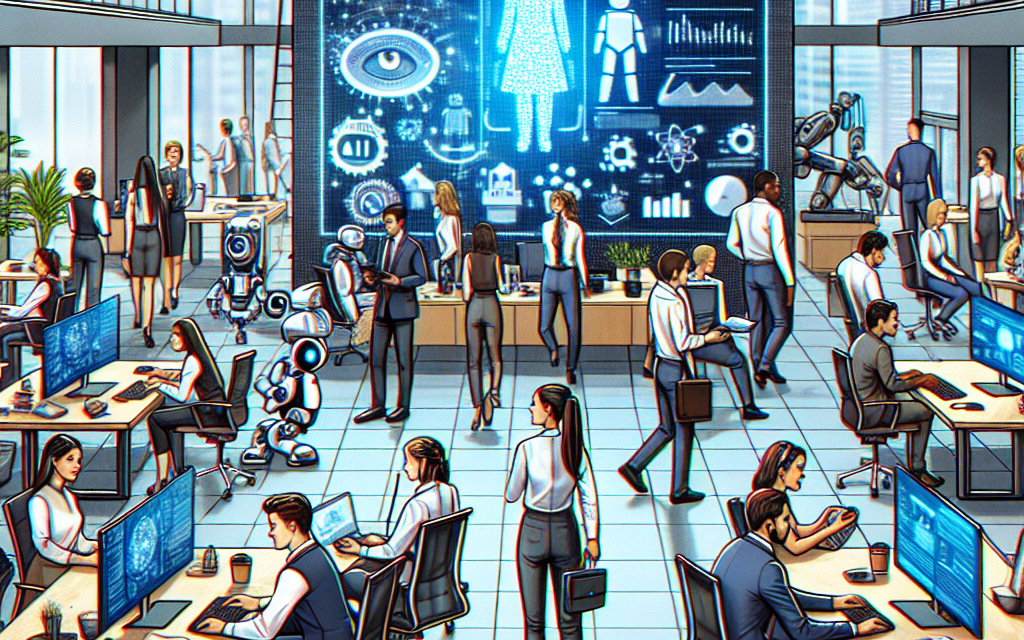Adapting to AI: How Organizations Are Evolving with Technological Advances
As artificial intelligence (AI) continues to evolve, organizations across various sectors are finding innovative ways to integrate these technologies into their operations. The rapid advancement of AI presents both challenges and opportunities, compelling businesses to adapt their strategies, processes, and workforce dynamics. This article explores how organizations are evolving with technological advances, focusing on five key areas: workforce transformation, operational efficiency, customer engagement, ethical considerations, and future trends.
1. Workforce Transformation: Reskilling and Upskilling
The integration of AI into the workplace is reshaping job roles and responsibilities. As machines take over repetitive tasks, the demand for human skills is shifting towards more complex and creative functions. Organizations are recognizing the need to reskill and upskill their workforce to remain competitive in this new landscape.
According to a report by the World Economic Forum, by 2025, 85 million jobs may be displaced by a shift in labor between humans and machines, while 97 million new roles may emerge that are more adapted to the new division of labor. This statistic underscores the urgency for organizations to invest in their employees’ development.
- Reskilling Initiatives: Many companies are implementing reskilling programs to help employees transition into new roles. For instance, AT&T has invested over $1 billion in training programs to prepare its workforce for the digital age. This initiative includes partnerships with educational institutions to provide employees with access to relevant courses.
- Upskilling for Advanced Roles: Upskilling focuses on enhancing existing skills to meet the demands of evolving job roles. Companies like Amazon have introduced programs such as “Upskilling 2025,” which aims to train 100,000 employees in high-demand fields like cloud computing and machine learning.
- Collaboration with Educational Institutions: Organizations are increasingly collaborating with universities and training providers to create tailored programs that address specific skill gaps. For example, IBM has partnered with various universities to develop curricula that align with industry needs, ensuring that graduates are job-ready.
Moreover, the rise of online learning platforms has made it easier for employees to access training resources. Platforms like Coursera and Udacity offer courses in AI, data science, and other relevant fields, enabling employees to learn at their own pace. This democratization of education is crucial for fostering a culture of continuous learning within organizations.
In conclusion, workforce transformation through reskilling and upskilling is essential for organizations to thrive in an AI-driven world. By investing in their employees’ development, companies can not only enhance productivity but also foster a more engaged and adaptable workforce.
2. Operational Efficiency: Streamlining Processes with AI
AI technologies are revolutionizing operational efficiency by automating routine tasks, optimizing workflows, and enhancing decision-making processes. Organizations are leveraging AI to streamline operations, reduce costs, and improve overall productivity.
One of the most significant applications of AI in operational efficiency is in supply chain management. Companies like Walmart and Amazon utilize AI algorithms to predict demand, manage inventory, and optimize logistics. For instance, Walmart employs machine learning models to analyze historical sales data and forecast future demand, allowing them to maintain optimal inventory levels and reduce waste.
- Automation of Routine Tasks: AI-powered tools can automate repetitive tasks such as data entry, invoice processing, and customer inquiries. This not only frees up employees to focus on more strategic activities but also reduces the likelihood of human error. For example, chatbots are increasingly used in customer service to handle common queries, providing instant responses and improving customer satisfaction.
- Data-Driven Decision Making: AI enables organizations to analyze vast amounts of data quickly and accurately. By leveraging predictive analytics, companies can make informed decisions based on real-time insights. For instance, Netflix uses AI algorithms to analyze viewer preferences and recommend content, enhancing user engagement and retention.
- Process Optimization: AI can identify inefficiencies in workflows and suggest improvements. For example, General Electric (GE) employs AI to monitor its manufacturing processes, identifying bottlenecks and optimizing production schedules. This approach has led to significant cost savings and increased output.
Furthermore, AI can enhance project management by predicting project timelines and resource requirements. Tools like Microsoft Project and Asana are incorporating AI features to help teams plan and execute projects more effectively. By analyzing historical project data, these tools can provide insights into potential risks and suggest mitigation strategies.
In summary, AI is a powerful catalyst for operational efficiency. By automating routine tasks, enabling data-driven decision-making, and optimizing processes, organizations can achieve significant improvements in productivity and cost-effectiveness.
3. Customer Engagement: Personalization and Experience Enhancement
In today’s competitive landscape, customer engagement is paramount. Organizations are increasingly using AI to enhance customer experiences through personalization and targeted marketing strategies. By analyzing customer data, businesses can tailor their offerings to meet individual preferences and needs.
Personalization is a key driver of customer loyalty. According to a study by Epsilon, 80% of consumers are more likely to make a purchase when brands offer personalized experiences. Companies like Spotify and Amazon have successfully leveraged AI to create personalized recommendations based on user behavior and preferences.
- AI-Driven Recommendations: E-commerce platforms utilize AI algorithms to analyze customer browsing and purchase history, providing personalized product recommendations. For instance, Amazon’s recommendation engine accounts for approximately 35% of its total sales, demonstrating the effectiveness of personalized marketing.
- Chatbots for Enhanced Customer Service: AI-powered chatbots are transforming customer service by providing instant support and assistance. Brands like Sephora and H&M use chatbots to engage customers, answer queries, and guide them through the purchasing process. This not only improves customer satisfaction but also reduces the workload on human agents.
- Sentiment Analysis for Feedback: Organizations are using AI to analyze customer feedback and sentiment on social media and review platforms. By understanding customer sentiments, companies can make data-driven decisions to improve their products and services. For example, Starbucks uses sentiment analysis to gauge customer reactions to new menu items and adjust their offerings accordingly.
Moreover, AI can enhance customer engagement through targeted marketing campaigns. By segmenting customers based on their behavior and preferences, organizations can deliver personalized content that resonates with their audience. For instance, Netflix uses AI to create tailored marketing campaigns that promote shows and movies based on individual viewing habits.
In conclusion, AI is revolutionizing customer engagement by enabling organizations to deliver personalized experiences and enhance customer interactions. By leveraging AI-driven insights, businesses can foster stronger relationships with their customers and drive brand loyalty.
4. Ethical Considerations: Navigating the AI Landscape
As organizations increasingly adopt AI technologies, ethical considerations surrounding their use have come to the forefront. Issues such as data privacy, algorithmic bias, and transparency are critical for organizations to address as they navigate the AI landscape.
Data privacy is a significant concern, especially with the implementation of regulations like the General Data Protection Regulation (GDPR) in Europe. Organizations must ensure that they handle customer data responsibly and transparently. Failure to comply with data protection laws can result in severe penalties and damage to a company’s reputation.
- Algorithmic Bias: AI systems can inadvertently perpetuate biases present in the data they are trained on. For example, a study by ProPublica found that an AI algorithm used in the criminal justice system was biased against African American defendants, leading to unfair sentencing. Organizations must actively work to identify and mitigate biases in their AI models to ensure fair outcomes.
- Transparency and Accountability: Organizations should strive for transparency in their AI processes. This includes providing clear explanations of how AI systems make decisions and ensuring accountability for their outcomes. Companies like Google have established AI ethics boards to oversee the development and deployment of AI technologies, promoting responsible practices.
- Ethical AI Frameworks: Many organizations are developing ethical AI frameworks to guide their AI initiatives. For instance, Microsoft has published its AI principles, which emphasize fairness, reliability, privacy, and inclusiveness. By adhering to these principles, organizations can build trust with their stakeholders and mitigate ethical risks.
Furthermore, organizations must engage in ongoing dialogue with stakeholders, including customers, employees, and regulators, to address ethical concerns related to AI. By fostering a culture of ethical awareness, companies can navigate the complexities of AI adoption while maintaining public trust.
In summary, ethical considerations are paramount as organizations adapt to AI technologies. By addressing issues such as data privacy, algorithmic bias, and transparency, companies can ensure responsible AI practices that benefit both their business and society at large.
5. Future Trends: The Next Frontier of AI in Organizations
The future of AI in organizations is promising, with emerging trends poised to reshape industries and redefine business models. As technology continues to advance, organizations must stay ahead of the curve to leverage the full potential of AI.
One significant trend is the rise of AI-powered automation. According to McKinsey, up to 45% of current work activities could be automated using existing technologies. This shift will lead to increased efficiency and cost savings for organizations, but it will also require a reevaluation of workforce dynamics.
- AI in Decision-Making: Organizations are increasingly using AI to support decision-making processes. Advanced analytics and machine learning algorithms can provide insights that inform strategic choices. For example, companies like Procter & Gamble use AI to analyze market trends and consumer behavior, enabling them to make data-driven decisions about product development and marketing strategies.
- Integration of AI with IoT: The convergence of AI and the Internet of Things (IoT) is creating new opportunities for organizations. By combining AI with IoT devices, companies can gather real-time data and make informed decisions. For instance, smart manufacturing systems use AI to analyze data from connected machines, optimizing production processes and reducing downtime.
- AI-Driven Innovation: Organizations are leveraging AI to drive innovation in product development and service delivery. Companies like Tesla use AI algorithms to enhance their autonomous driving capabilities, pushing the boundaries of technology and redefining the automotive industry.
Moreover, the democratization of AI tools is enabling smaller organizations to harness the power of AI without significant investments. Cloud-based AI services from providers like Google Cloud and Microsoft Azure allow businesses of all sizes to access advanced AI capabilities, leveling the playing field.
In conclusion, the future of AI in organizations is characterized by automation, enhanced decision-making, and innovation. As businesses continue to adapt to these trends, they must remain agile and open to change to thrive in an increasingly AI-driven world.
Conclusion
The integration of AI into organizational practices is not merely a trend; it is a fundamental shift that is reshaping the business landscape. From workforce transformation and operational efficiency to customer engagement and ethical considerations, organizations are evolving to harness the power of AI technologies. As we look to the future, it is clear that those who embrace these changes will be better positioned to thrive in an increasingly competitive environment.
Key takeaways from this exploration include:
- The importance of reskilling and upskilling the workforce to adapt to new roles created by AI.
- The role of AI in streamlining operations and enhancing productivity through automation and data-driven decision-making.
- The necessity of personalizing customer experiences to foster loyalty and engagement.
- The critical need for organizations to address ethical considerations surrounding AI adoption.
- The emerging trends that will shape the future of AI in organizations, including automation, IoT integration, and democratization of AI tools.
As organizations continue to navigate the complexities of AI adoption, a proactive approach to embracing technological advances will be essential for long-term success. By fostering a culture of innovation and ethical responsibility, businesses can not only adapt to AI but also thrive in the new era of technology.





